Special Report: Digital Signage – Transforming Surfaces with Projection Mapping
by all | 17 September 2014 12:00 pm
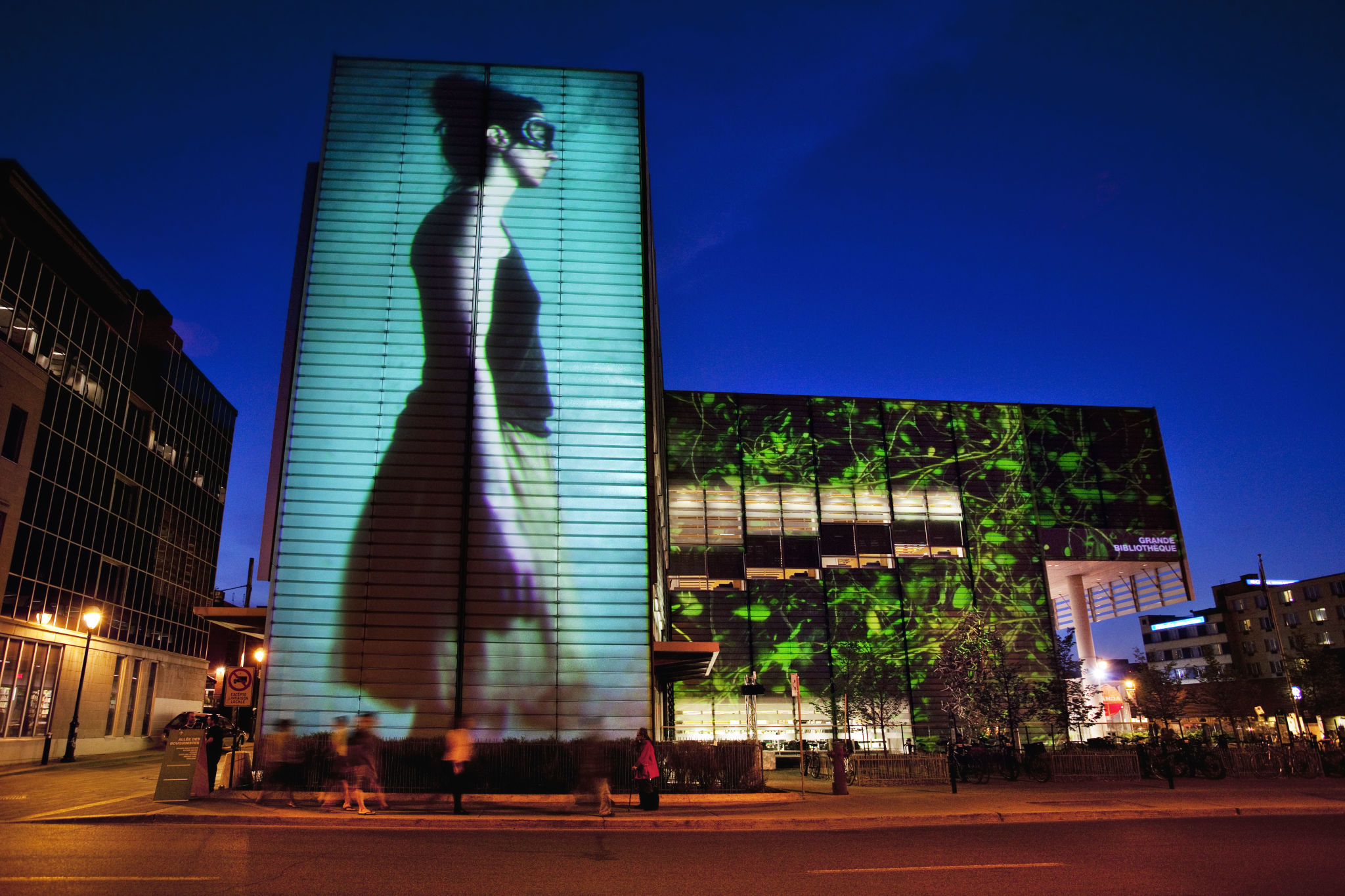 [1]
[1]Photos courtesy Christie
By Mike Garrido
In today’s world of digital signage technologies, dynamic displays are not only at our fingertips, but also becoming integrated into our environments. The industry now has the tools and knowledge to virtually transform physical structures with extremely large visuals. A growing global demand for bigger, bolder graphics is pushing artists and content creators to move beyond the traditional boundaries of a flat screen or video wall and use projection mapping to turn entire buildings, monuments and other large structures into an edge-free canvas.
Projection mapping taps into both art and science to enhance these three-dimensional (3-D) structures. Previously also known as video mapping or spatial augmented reality (AR), it has grown in popularity to complement large corporate events and installations for governments, entertainers and brand marketers.
“Projection mapping is an art form, but also about calculations for everything from colour saturation to height and distance,” says Kathryn Cress, vice-president (VP) of global and corporate marketing for projector manufacturer Christie. “It’s about getting the geometry right for the surfaces being transformed.”
“I like to do a project in such a way that it looks very organic,” says Bart Kresa, a master projection designer with his own studio. “It’s magic when the audience doesn’t really know how it happens. We try to make it impossible to comprehend what’s going on before their eyes.”
The history of an art form
The specific art of transforming a large surface using projections traces back several decades. Some say the first commercial instance of projection mapping onto complex curved surfaces were ghostly, disembodied, singing heads that debuted at the Haunted Mansion ride at Disneyland in Anaheim, Calif., in the 1960s.
Artists started taking the medium outdoors in the 1980s using powerful, large-format projectors. Hand-painted slides were projected onto public façades to illuminate them at night.
In the mid-1990s, the projected slides were divided into sections, allowing images to be wrapped perfectly to the proportions of the selected buildings. Some of these graphics extended onto the streets, too.
The introduction of brighter, computer-driven commercial projectors led to greater possibilities. Computer graphics sped up production and made full-motion video and graphics possible without film. Staging companies began keeping these projectors in their rental inventory, allowing fast turnaround for event production.
As the equipment continued to become brighter, portable and more rugged, intrigued artists started to look at the shapes, contours and colours of large buildings and wonder how they could incorporate them into their work. Many of their projects for businesses were visual tricks to stun onlookers, such as sea creatures swimming inside office towers.
With the further evolution of digital simulation, visualization and projection technologies, truly awe-inspiring displays have been achieved around the world in recent years, from the 2012 World Expo in Yeosu, South Korea, to the grand opening of the Atlantis Resort in Dubai, U.A.E. The best projects move beyond the earlier ‘wow’ factor to tell a story. The following are just a few Canadian examples.
 [2]
[2]The Luminous Pathway in Montreal’s Quartier des Spectacles began with simple red dots on sidewalks and now includes fully projection-mapped buildings.
Luminous Pathway
Originally conceived in 2006 to add excitement in Montreal’s Quartier des Spectacles, a district with 80 per cent of the city’s performance halls, the Luminous Pathway began with simple red dots shone onto sidewalks and has since grown to incorporate fully projection-mapped buildings, custom-illuminated intersections and ambient architectural lighting.
Today, with the municipal government’s support, climate-protected projectors of various sizes are permanently fixed onto buildings throughout the district, with more continuing to be added and made available to artists as public canvases.
“It has really caught on,” says Mikaël Charpin, deputy director of the not-for-profit Luminous Pathway partnership. “When building owners see projection mapping on someone else’s wall, they then want us to use their wall, too.”
“Every image must meet certain criteria before it’s considered for display,” says Ivan Klein, technical director. “Videos have to express the theme of the building they’re displayed on.”
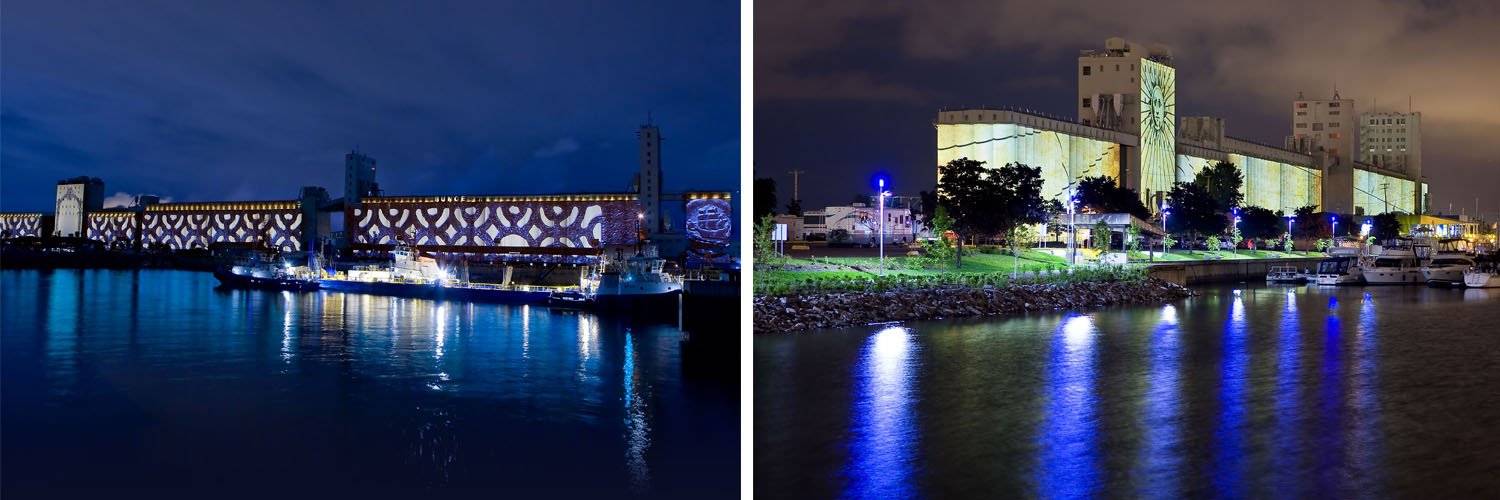 [3]
[3]In 2008, 81 grain silos along the St. Lawrence River were mapped and used as a giant screen to celebrate the 400th anniversary of Quebec City. Photos ©2007 Francis Vachon
The Image Mill
In 2008, 81 working grain silos along the St. Lawrence River were mapped and used as a giant screen to celebrate the 400th anniversary of Quebec City. Famed multimedia artist Robert Lepage created the Image Mill, a 40-minute spectacle, as an ode to his birthplace, which he called “the best-kept secret in North America.”
The Image Mill brought Quebec City’s story and culture to life on a 30 x 657-m (100 x 2,155-ft) canvas over 10 weeks. At the time, it was the largest projection surface ever created, earning a spot in the Guinness Book of World Records. The nightly showcase transformed the silos into rows of books, stained glass windows, a printing press, cigarettes, bullets and even other buildings, including a factory and an airport.
Lepage and his company, Ex Machina, took more than two years to plan and create the Image Mill, working with a French firm, ETC France. They needed 27 projectors to create a continuous image across the silos and around one side, along with kilometres of cabling for control and communications. Much of the planning was dedicated to accurately mapping images onto the uneven concrete contours of the silos and allowing for obstructions in the projection path like trees, buildings and electrical poles and wires.
The show was so popular, it was extended through the following five summers.
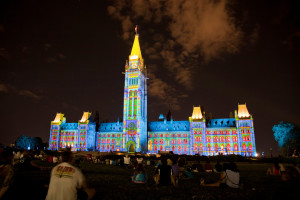 [4]
[4]On summer nights from 2010 to 2014, the National Capital Commission (NCC) and Moment Factory projected the Mosaika light show onto the centre block of Ottawa’s Parliament Hill. Photo courtesy NCC
Mosaika
From 2010 through 2014, the centre block of Ottawa’s Parliament Hill was illuminated each summer with ‘Mosaika – Canada Through the Eyes of Its People,’ depicting the country’s history with a sound-and-light narrative.
Organized by the National Capital Commission (NCC) and designed by Montreal-based Moment Factory, the show projected video content across the 144-m (472-ft) wide building, including the 75-m (246-ft) tall Peace Tower.
“After Moment Factory did a full pixel mapping of the buildings, our biggest challenge was how to repeat the placement of the projectors to ensure a perfect performance every night,” says Jean-Marc Beauvalet, NCC’s manager of technical services. “The solution for the projectors that stayed on the hill was to place them on hydraulic lifts with repeatable heights. They have sensors that stop them at the exact position.”
The 2013 edition of Mosaika went on to top the digital signage category and win ‘best in show’ in Sign Media Canada’s 2014 National Sign Competition.
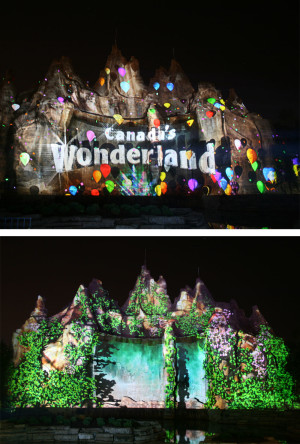 [5]
[5]Canada’s Wonderland launched Starlight Spectacular in 2011. Since then, it has become a standard feature for the theme park. Photos courtesy Christie
Starlight Spectacular
In 2011, Cedar Fair Entertainment mandated each of its theme parks must develop a nighttime show, including its only Canadian property: Canada’s Wonderland in Vaughan, Ont.
Doug McBoyle, Wonderland’s technical and event services manager, worked with his team to go beyond the mandated specification and develop Starlight Spectacular, a nearly 10-minute projection-mapped show that would close the park every evening. They were assisted by Tantrum Productions and Westbury National Show Systems, both based in nearby Toronto.
Starlight Spectacular is projected onto the park’s central feature, the manmade Wonder Mountain, making it appear overgrown with foliage, populated by butterflies, covered in snow, made red hot by lava, crumbled, rebuilt and occupied by a fire-breathing dragon.
“We want guests to walk away feeling good about what they just saw,” says McBoyle. “I think we achieved that. At the end of the day, they can regroup, see a spectacular show and go home having had a great time.”
Today, Starlight Spectacular remains a standard closing feature at Wonderland.
Hot@175
In 2012, Canadian luxury apparel retail chain Holt Renfrew celebrated 175 years in business. As part of these celebrations, a nine-minute, 4K-resolution video presentation—titled ‘Hot@175 Now and Forever’—was developed for projection onto the 50-m (165-ft) wide bulkhead at Holt Renfrew’s flagship store on Toronto’s Bloor Street West.
Rose & Thistle Media mapped the dimensions of the bulkhead’s 700-plus tiles and incorporated archival images and full-motion video to celebrate the retailer’s past, present and future. The tiles appeared to ripple, models danced in virtual windows and image mosaics filled the space.
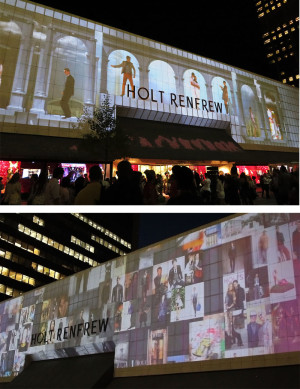 [6]
[6]In 2012, Holt Renfrew celebrated its 175th anniversary with a 4K video presentation in Toronto. Photos courtesy Westbury National
In addition to drawing big nighttime crowds, the show went on to win digital signage awards for its creativity.
Winter Dreams
In February 2013, Quebec City’s Palais Montcalm concert hall was painted in light as a preview of LumoCité, North America’s first
international projection mapping competition, in 2014. Called ‘Winter Dreams,’ the light show on the stone building—built circa 1931—explored the premise of what the world would look like if the city’s winter carnival snowman mascot could dream. Icicles appeared to drape the structure while water filled the building and whales swam across the facade.
The project was developed by Philippe Bergeron and undertaken by his company, PaintScaping, based in sunnier Los Angeles, Calif.
“Despite temperatures in the -30s, this was an incredible experience the PaintScaping team will never forget,” said Bergeron.
Mike Garrido is a senior product manager for Christie. This article is based on the company’s recent publication, The Book of Transformations. For more information, visit www.christiedigital.com.
- [Image]: http://www.signmedia.ca/wp-content/uploads/2014/09/BAnQ-11.jpg
- [Image]: http://www.signmedia.ca/wp-content/uploads/2014/09/edit1.jpg
- [Image]: http://www.signmedia.ca/wp-content/uploads/2014/09/edit2.jpg
- [Image]: http://www.signmedia.ca/wp-content/uploads/2014/09/Mosaika31.jpg
- [Image]: http://www.signmedia.ca/wp-content/uploads/2014/09/edit3.jpg
- [Image]: http://www.signmedia.ca/wp-content/uploads/2014/09/edit4.jpg
Source URL: https://www.signmedia.ca/special-report-digital-signage-transforming-surfaces-with-projection-mapping/